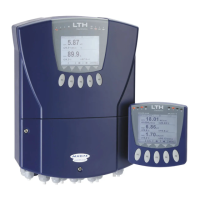Appendix
MXD70 Conductivity Setup and
Operating Guide
- 33 -
Appendix
Appendix A - Ultra Pure Water
UPW cell positioning, flow rate and sampling
This summary of ASTM D5391-93, combined with LTH application notes applies to ultra-pure water
applications only. These applications are very specific in nature and require great care to avoid errors in
measurement.
Pure water conductivity or resistivity must be measured with a cell and temperature sensor in a
flowing, closed system to prevent trace contamination from wetted surfaces and from the atmosphere.
Specialised temperature compensation can be used to correct the measurement to a reference
temperature of 20 or 25°C taking into account the temperature effects on the ionisation of water, the
contaminates and interactions between the two.
The cell constant for the precision cell has been determined with a secondary standard cell that has a
cell constant determined by ASTM D1125.
Conductivity or resistivity can be used for detecting trace amounts of ionic contaminants in water. It is
the primary means of monitoring the performance of demineralisation and other high purity water
treatment operations.
It is used to detect ionic contamination in boiler waters, microelectronics rinse waters, pharmaceutical
process waters and to monitor and control the level of boiler and power plant cycle treatment
chemicals.
Exposure of the sample to atmosphere will cause changes in the conductivity or resistivity due to loss
or gain of dissolved gases. CO
2
can reach an equilibrium concentration in water of about 1 mg/l and
add up to 1 μS/cm to the conductivity due to the formation of carbonic acid. This process is quite fast,
depending upon conditions.
Cell, flow chamber and sample line surfaces will slowly leach trace ionic contaminates, evidenced by
increasing conductivity readings with very low or zero flow rate. There must be sufficient flow to keep
these contaminates from accumulating to the point where they can significantly affect the
measurement. The large and convoluted surface of platinised cells precludes their use for high purity
measurements for this reason.
Samples containing dissolved gases must have sufficient flow through the cell so that bubbles cannot
accumulate and occupy sample volume within the cell, causing low conductivity (high resistivity)
readings.
High purity conductivity measurement must not be made on a sample downstream of pH sensors due
to the possible contamination of the sample with traces of reference electrolyte salts. Use a dedicated
sample line or place the conductivity cell up stream from the pH sensors.
Conductivity cells mounted downstream from ion exchangers are vulnerable to catching ion exchange
resin particles between the cell electrodes.
Resin particles are sufficiently conductive to short circuit the cell and cause high off scale conductivity
or extremely low resistivity readings.

